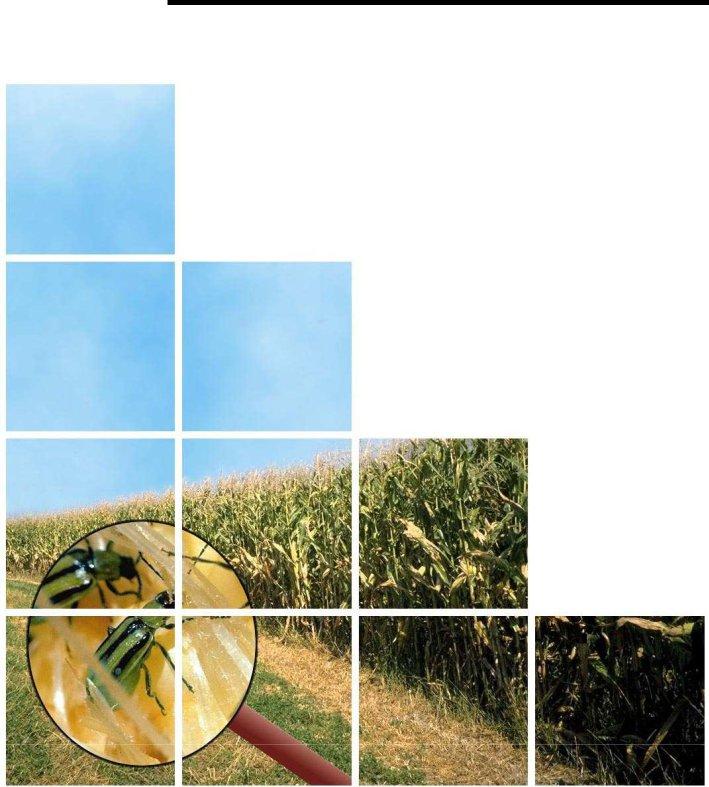Farmers and consultants striving for optimal corn production understand the importance of rigorous and detailed field monitoring, better known as crop scouting. This activity is crucial for identifying pest pressures early on and making informed pest management decisions. The Crop Scouting Report form, as outlined in the A3547 Corn Integrated Pest Management Program from the University of Wisconsin–Extension, provides a structured approach to recording and analyzing field observations. It emphasizes the necessity for a comprehensive understanding of pest and crop biology, efficient pest identification techniques, accurate sampling methods, and knowledge of economic thresholds. This form ensures that every scouting report gives a clear, unbiased picture of pest populations, enabling precise control measures to be determined. It also facilitates record-keeping, which is invaluable for tracking field history and making future management decisions. Details such as scouting frequency, patterns, and the importance of equipment are meticulously outlined to ensure the effectiveness of each scouting expedition. Furthermore, it delves into specific procedures for stand counts, weed scouting, disease monitoring, and nematode sampling, alongside guidelines for scouting various insects that may impact corn yield, thereby equipping scouts with the knowledge to conduct thorough assessments. This form serves as a critical tool for maintaining crop health and maximizing production efficiency.
| Question | Answer |
|---|---|
| Form Name | Crop Scouting Report Template Form |
| Form Length | 15 pages |
| Fillable? | No |
| Fillable fields | 0 |
| Avg. time to fill out | 3 min 45 sec |
| Other names | crop scouting printable, crop scouting form, crop scouting apps, crop scouting |

A3547
Corn
Integrated Pest Management Program - University of
CropScoutingManual
AGuidefor
Wisconsincornproduction

ScoutingCorn: Aguidetoefficientpestscouting
J. Doll, C. Grau, B. Jensen, J. Wedberg, J. Meyer
Introduction
Field monitoring, or scouting, is the backbone of all pest management programs. Before appropriate pest control decisions can be made, a detailed assessment of pest populations must be obtained. Efficient pest scouting requires a thorough knowledge of pest and crop biology, pest identification and habits, correct sampling methods, and economic thresholds (when available).
The goal of scouting is to give a complete, accurate and unbiased assessment of pest populations. The field scout is the link between the consultant and grower. Scouting report forms must be comprehensive enough so control decisions can be made directly from the report form. These forms not only serve as a record of current pest populations but should be saved by the growers or consultant as part of the field history records.
Scouting Frequency
The frequency with which visits must be made depends on the type of crop grown and pest(s) present or expected. Field visits must be scheduled such that increases in pest populations are detected as soon as economic thresholds are reached.Field corn should be monitored at weekly intervals until pollination is completed, at which time scouting frequency can be relaxed to approximately once every ten days. At this time there is little danger of pest levels exceeding the economic threshold level between visits. The field scouts, however, should always have flexible schedules to allow revisiting problem fields.
Scouting Patterns
Before a scout enters a field an appropriate route must be planned. For efficiency sake, an
You cannot scout one edge of the field and expect pest populations to be the same in other areas. Do not sample the edge of a field unless it is specifically recommended (i.e. stalk borer or weed scouting). Often pest populations found on the field edge do not indicate what is present in the rest of the field. The exception, of course, is contour strips, where the whole strip can be considered “edge.” When
Figure 1: Suggested field patterns
scouting contour strips, walk the middle of the contour and
The number of times a scout must stop to make specific counts will vary according to the type of pests found and will be discussed later in this bulletin.
For large fields (greater than fifty acres), the scout’s accuracy diminishes to the point where a field of this size or larger should be split into two separate fields. Separate fields according to geography, previous cropping history or soil type.
Field History Forms
Before the scouting season begins, growers should com- plete a Field History Form (Appendix A). It should contain such information as field location, cropping history, crop yields, pesticide use, fertilizer and lime applications, soil type, soil test records, major pest problems, and anything else that could make scouting more effective.
Scouting Report Forms
Whenever a field is scouted, a field report form (Appendices B or C) should be filled out and a copy left with the grower. Even if damaging levels of pests are not found, farmers are still interested in general crop health and growth stage. These forms should be filled out in triplicate with copies given to the grower, scout supervisor, and a copy should stay with the scout. As scouts prepare to walk individual

page 2 |
Corn Crop Scouting Manaual |
|
|
fields, they should familiarize themselves with past reports so problem areas can be closely monitored.
feet of row by the appropriate conversion factor (Table 1) to determine plant population.
Equipment
When monitoring corn a scout should carry the following equipment:
µscout report forms and clipboard pencil(s)
µpocket knife (for splitting stalks and cutworm scouting)
µmagnifying glass or hand lens for accurate pest identification
µbags, plastic vials and labels (for collecting plant and insect specimens for future identification)
µmechanical hand counter
µmeasuring tape
In addition the scout should have available in their vehicle:
µreference materials (in case problems are encoun- tered in the field)
µspade (for digging entire plant for pest identifica- tion)
µcooler with ice (to keep unknown weed, insect and disease samples fresh until accurate identification can be obtained)
Stand Counts
Stand counts should be made the second week after emergence. Count the number of plants in 20 linear feet of row from five randomly selected areas of a field. Measure the distance between rows in several locations within the field. Multiply the total number of plants counted in the 100
Row Width |
Conversion Factor |
|
|
30 inches |
174 |
36 inches |
145 |
38 inches |
138 |
40 inches |
131 |
|
|
|
|
For example, if you have counted a total of 145 plants and the row width was 30 inches, multiply 145 (plants) x 174 (conversion factor) = 25,230 plants per acre.
Table 1: Conversion factors to determine corn populations
Weed Scouting Procedure
The first weed survey should occur shortly after corn emergence and continue at weekly intervals until control options are no longer available. Scouts should record the relative weed abundance and growth stages at ten randomly selected sites. When moving between sites always look for pockets of problem weed infestations. Mark their location on a weed map (Appendix D) so growers can spot treat these areas if necessary. Continue adding to this weed map as the season progresses. This map should be as accurate as possible and include field boundaries and other points of reference (i.e. waterways, access roads and buildings).
Scouts can group individual weed populations into these four categories:
We do not have exact threshold numbers on a species by species basis at this time. Common sense and intuition should be the guides to determine the course of action in a given field.
Perennial broadleaves like Canada thistle, hemp dogbane, bindweeds, and Jerusalem artichoke usually occur in scattered patches. Yield loss in these areas can be very serious. The decision of what action is appropriate will be based on the percentage of the field infested, weed and crop growth stage, and distribution pattern of the patches.
In addition to yield losses, certain weeds can interfere greatly with harvest. Bindweeds and giant ragweed are examples of weeds that should be controlled regardless of

Aguidetoefficientpestscouting |
page 3 |
|
|
|
|
their impact on corn yield as they can greatly reduce harvest efficiency and increase machinery repair costs.
A comprehensive weed survey/map should be completed by the end of the scouting season. Growers can then develop a preventative weed control program, if necessary, based on weeds most likely to be present next season.
Corn Disease Scouting
Corn should be monitored for evidence of disease during each field visit. If seedling blights are present during the early season scouting, determine percent of plants infected by looking at 20 plants in each of five randomly selected areas within a field.
For leaf diseases, general remarks should be noted as to crop stage, percent of plants affected, percent of foliage infected, whether the disease is above or below the ear, and the location of the infestation within the field. Stalk rots evaluation should be treated differently. Use either the “squeeze test” (squeezing the lower internodes between thumb and forefinger, if tissue collapses then stalk rots are likely to be present) or the “push test” (pushing the plant
Sampling For Corn Nematodes
A nematode assay can be valuable to: 1) confirm a sus- pected nematode problem or 2) eliminate nematodes as one of several possible causes of poor plant growth.
The best results are obtained when soil and root samples are taken 6 to 10 weeks after planting. Nematode popula- tions at this time appear to correlate best with grain yield.
However, late summer or fall samples can also be useful in predicting next year’s problems.
Nematode damage to corn often appears in circular or oval pockets in the field. Rarely does an entire field show symptoms. Sample the suspected areas.
There are several ways to take a soil sample for nematode analysis. The following is a general guide.
1.Use a soil probe,
depth of 8 to 10 inches. Discard the upper 2 inches of soil, especially if it is dry. Be sure to include plant roots.
2.One sample is adequate per 10 acre field or suspected area within the field. Sample soil and roots from 10 plants and mix into one compos ite sample - 2 pints of soil is adequate. Sample from plants in the margins of suspected areas and not from their centers.
3.Place samples in sturdy plastic bags. Fasten the open end securely and accurately label samples. Keep the samples from becoming overheated. Mail samples early in the week to avoid delays in transit.
Corn Insect Scouting
Scouting methods for insects vary according to species present. The following are scouting guidelines for the major insect pests of Wisconsin field corn.
Seed Corn Maggot and Seed Corn Beetles
Scheduled scouting for seed corn maggots and seed corn beetle damage is unnecessary. However, if you find wilted, yellowed or stunted plants during seedling stand counts, or during cutworm or other soil insect scouting activities, check for damage from these insects. If numbers justify it, check 50 plants in 5 randomly selected areas of the field (250 plants) to determine percent damaged plants. Dig up and examine damaged seedlings and search for seeds in areas that have no plants to determine if skips are insect or planter related. Unlike the spotty nature of wireworm damage, damage from these insects will usually cover most of the field.
Wireworms
Like seed corn maggot and seed corn beetles, scheduled scouting for wireworms is not suggested. However, symp- toms of their activity may be observed during seedling stand counts or cutworm scouting. If wireworm damage is sus- pected, check 50 plants in 5 areas of the field to determine average percent of plants damaged. Dig up several dam- aged plants along with a
White Grubs
Routine scouting is not suggested. However, damage may be observed during seedling stand counts or cutworm surveys. If signs of white grub damage are found, make counts on 25 plants in 5 areas of the field to determine

page 4 |
Corn Crop Scouting Manaual |
|
|
percentage of damaged plants. Dig up suspect plants and examine the roots for signs of pruning; search for grubs in the soil immediately surrounding the root zone. Record the percent of damaged plants and number of grubs found.
Stalk Borer and
Start scouting for plant damage at emergence and until approximately
Cutworms
As corn plants emerge, check 5 groups of 50 plants. Cutworm infestations are already started by the time corn is planted. Low, wet fields or low, wet areas within fields have a greater probability of attack from black cutworms. Re- duced tillage, weed growth prior to tillage, and late planting are also suspected of contributing to cutworm problems. Some Wisconsin farmers have experienced severe cutworm damage in first year corn following spring plowed sod or alfalfa/grass sod.
Check for cutworms on and below the soil surface adjacent to damaged plants. Occasionally cutworms will be found under crop residue, soil clods, or in soil cracks. Count and record the number of damaged plants (leaf feeding, cut, or wilting), the number and size of cutworms and crop stage.
Corn Leaf Aphid
Examine 10 sets of 5 consecutive plants for corn leaf aphids during the late whorl to early tassel emergence stages. The aphids initially will be found in the whorl of younger plants and later on the tassel.
Start scouting for aphids just prior to or during the tassel emergence period. You will, of course, have to pull the whorl leaves, unroll them, and search for aphids.
Because parasites, predators, and diseases will often keep aphids under control, it is important to note and record their presence. Look for lady beetles and lady beetle larvae, lacewing larvae (aphid lions) and syrphid fly maggots. The aphid colonies may have brown or golden aphids; these are diseased or parasitized.
Corn Rootworms
Make three counts of both species of beetles at
number of western and northern rootworm beetles on 50 plants (10 sets of 5 plants) each time. Do not select adja- cent plants at each location; approach plants with caution because the beetles are easily disturbed. Leave a space of about
Count the beetles on the entire plant, including the ear tip, the tassel, the leaf surfaces and behind leaf axils. When approaching a plant, grasp the ear tip firmly with one hand while you use the other to search for beetles on the rest of the plant. When you are ready to examine the silks and ear tip for beetles, open your hand carefully so none of the beetles escape unnoticed. Expose the ear tip as some beetles may be feeding on developing kernels.
The purpose of this scouting is twofold. First, accurate counts are necessary to determine if the silks need insecti- cide protection against beetle feeding. Because of this, one of the counts must be made at the onset of silking. The second purpose is to determine the potential for rootworm larval damage to corn planted the following year in the field.
European Corn Borer
First Generation. Scouting activity for first generation European corn borer must begin at 700 borer degree days (base 50 degrees Fahrenheit). In southern Wisconsin, this can occur as early as the first week of June .
Examine 10 random sets of
Larvae are susceptible to chemical control for only
Second Generation Scouting. Egg scouting is necessary after tassels emerge;
•White (W) - eggs are newly laid
•Cream (C) - intermediate